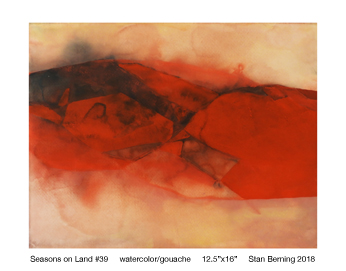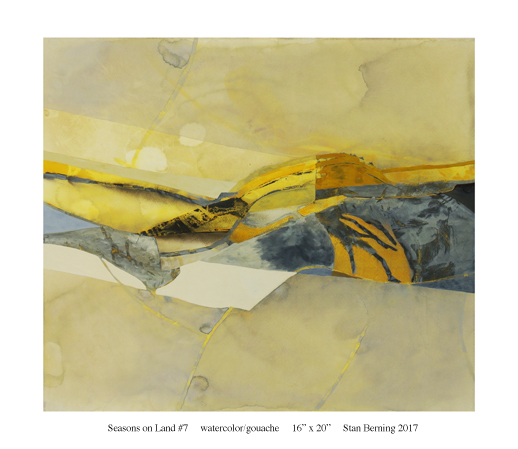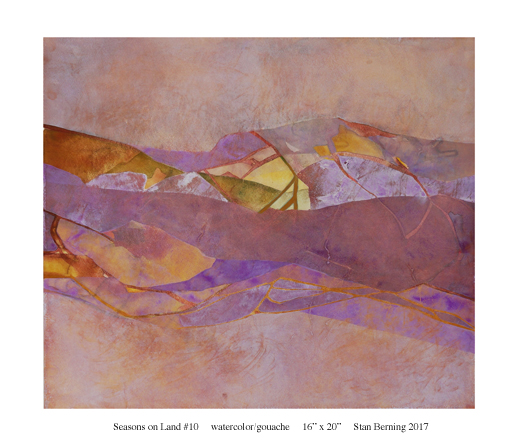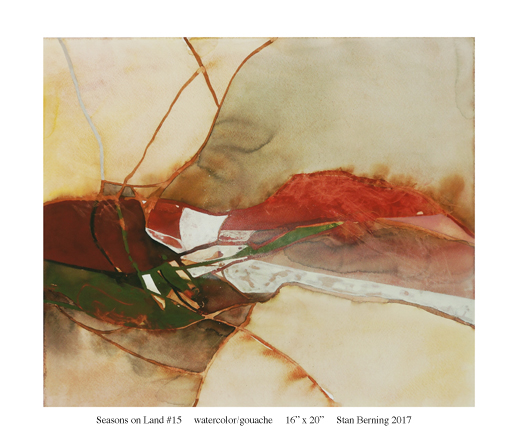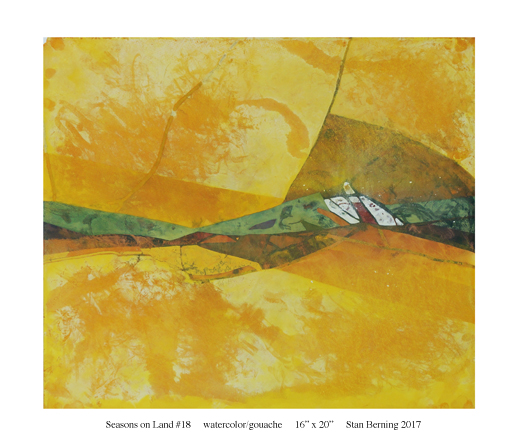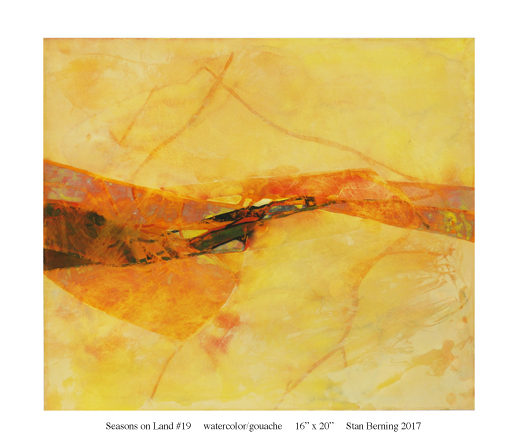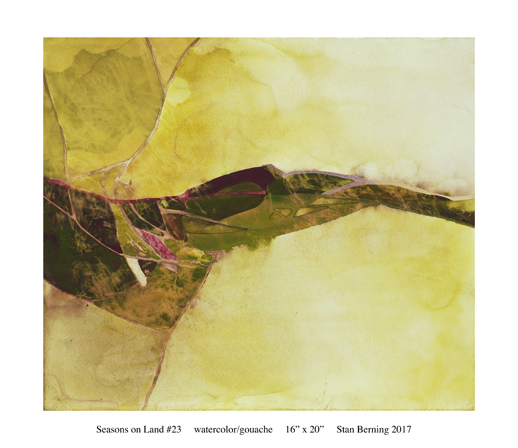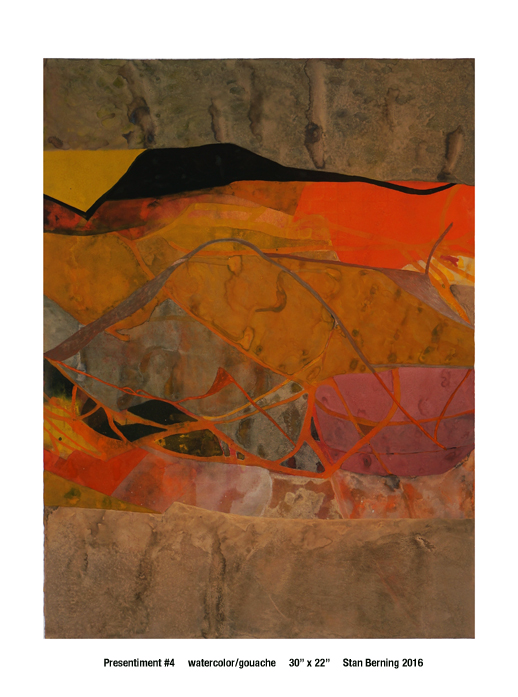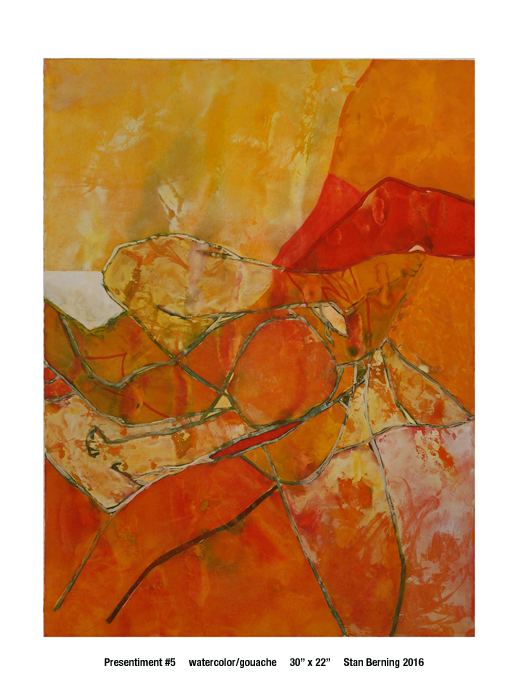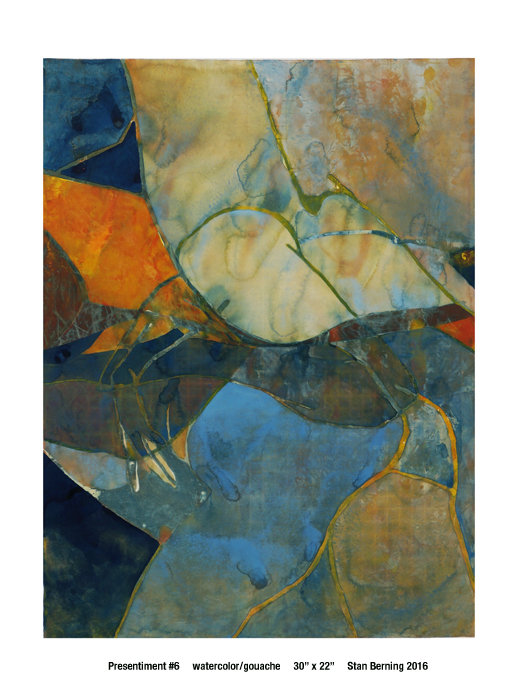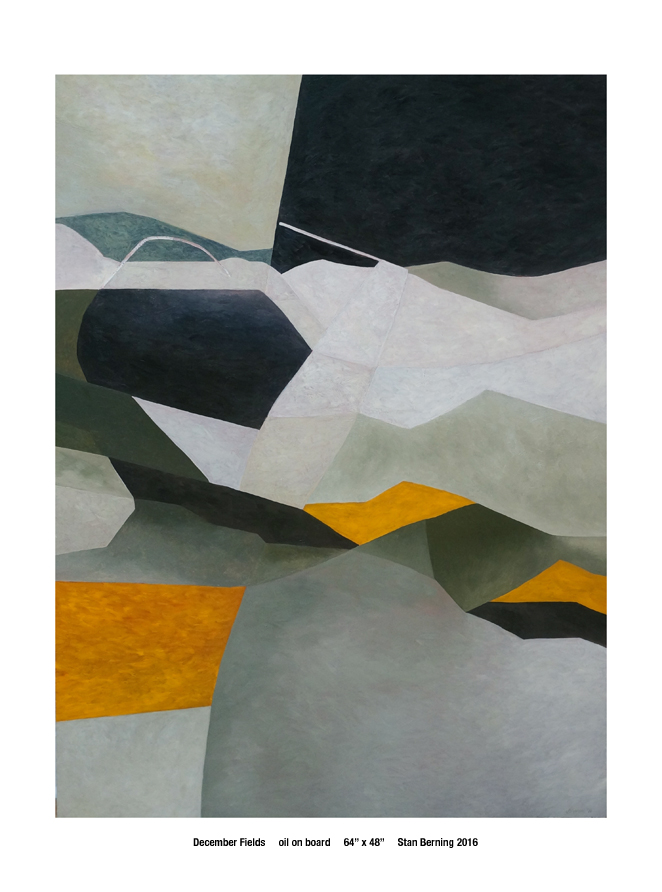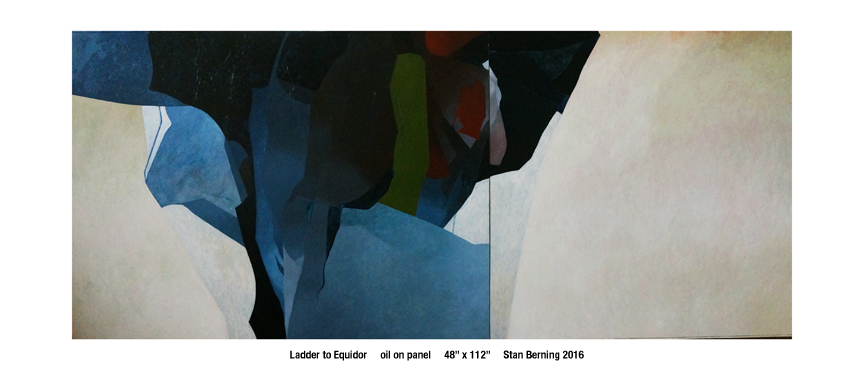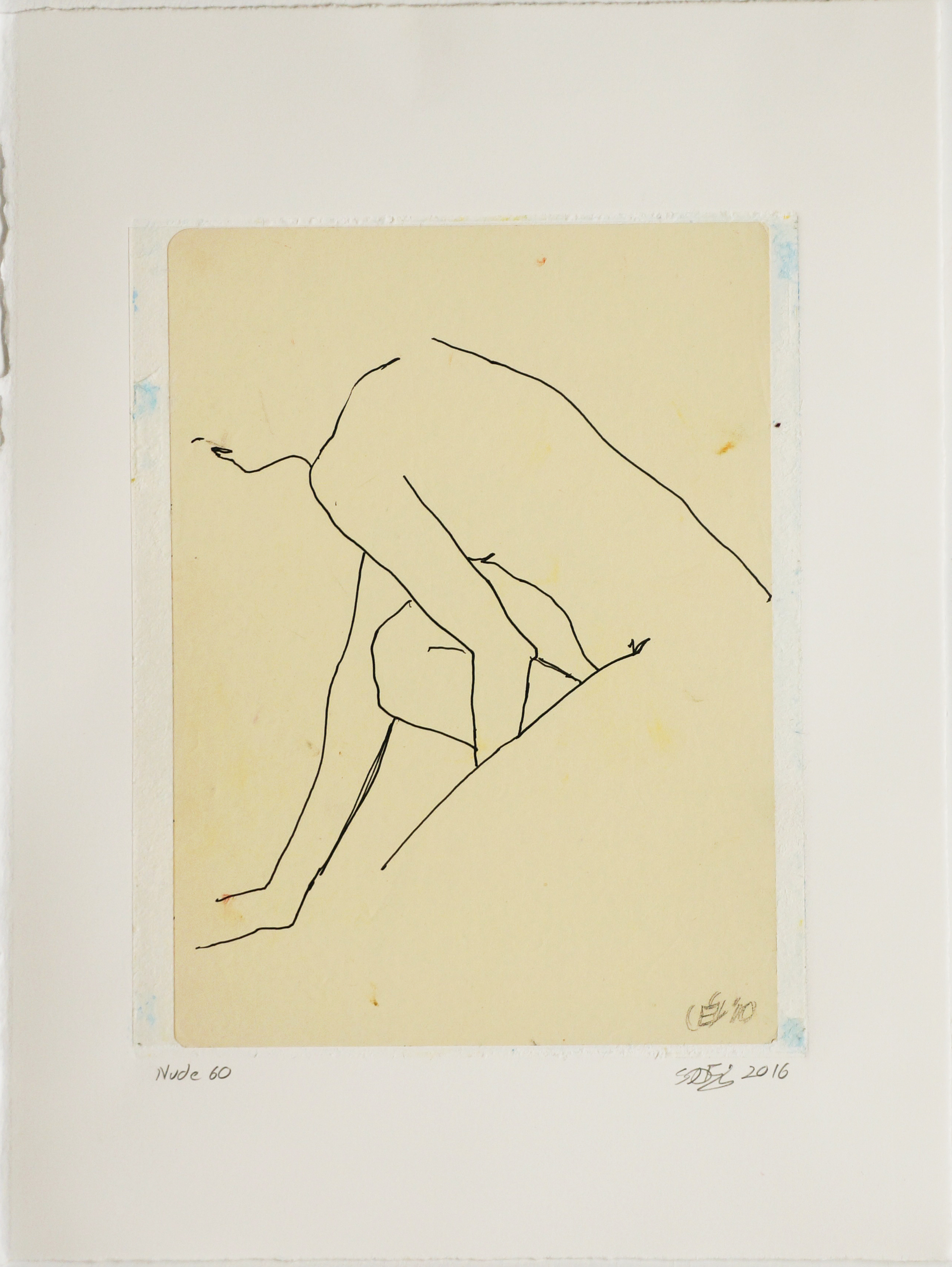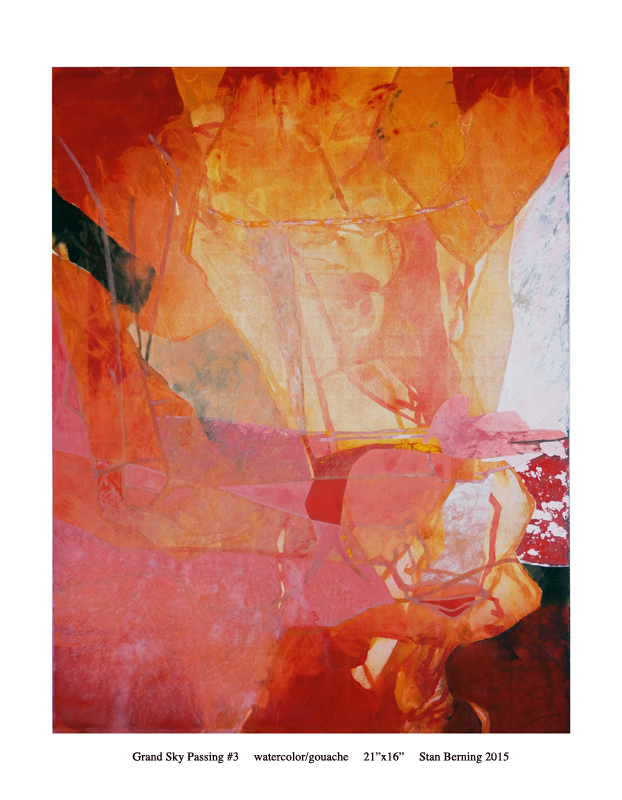This is a show proposal I recently prepared for a museum specializing in the figurative arts. I imagined this to be the foundation for a catalogue raisonné
……….
Stan Berning
“A Figurative Derivation”
paintings from 2002 to present
The medium in which I first discovered my voice was watercolor. This fluid paint, rich in the mythos of unintended consequence, taught me to believe in the accident as a tool to enlightenment and forward progress.
As a young man, just arrived to New Mexico, I drove for Pony Express, a courier service. My route took me between Santa Fe, Los Alamos, and Espanola at all times of the day and night and through all seasons and weather. In the triangle between these three cities lies a geology forming one of the most beautiful places on earth. As I drove I would come upon constantly changing natural visions of cloud, desert, mountain, and sky. I practiced memorizing those rapidly disappearing vignettes. Taking them home with me, I would then try to paint them. While studying the layering of a mist — a horizontal band of white and gray turned pinkish in the early morning light and as seemingly substantial as the earth itself with the peaks of the Jemez Range sitting firmly above and upon it, the golden autumn cottonwoods along the Rio Grande river meandering below — my permeable subconscious was plumbed to its depths as spaces were rearranged within my chest. The experiences of those drives, reinforced and made indelible by my exercises in memory and visualization, have continued to influence the work I create, making possible many of the stacked spacial arrangements of my architectural series and guaranteeing even my most nonrepresentational work’s impulse towards the majesty of the landscape. Twenty years later the late days of the high summer of my career would find me in a 2000 square foot studio in Santa Fe, NM.
From the skylight, 20 feet above my head, I am bathed in a perfect well of light. I stand at my work table mixing paint. Before me on a large rolling easel sits a 4 x 6 foot painting. Described within the plane of this picture are vast tectonic plates moving and shifting as they contend with one another; a subtle and endless movement intended to hold the viewers attention… forever. The painting, divided nearly in half by aggressively incised lines made with a large metal straight edge and the nub of a blunt plastic pen, has reached the stage where all egg tempera paintings eventually must go. I work in silence, carefully mixing the paint to exacting hues and, with a small brush and infinite patience, carefully modulate these final moments in search of a perfect balance. An admirable journey of thousands of images done over the years has brought me to this one painting. It is not the best painting I have done. It is only another painting – a link in a chain of paintings – but it is the last painting of this series of wildly popular images which has been 15 years in the making. I am not aware, at this moment, that this painting is the last. It is the autumn of 2001. I am 50 years old. I do not realize summer is coming to an end.
The brushes have been cleaned and neatly returned to my work table. The painting has sat, all night, in the darkness, waiting passively as I have slept. Over my first cup of coffee I take one more hard look and decide it is finished. It is moved to a corner of the room and out of my field of vision. I pull out another white gessoed panel and place it on a second paint spattered easel. During the course of the day I have lunch with friends, take my dog for a walk, and mix the mud of five different pigments which has become my black and starting point. Towards evening I take the largest brush from my can of brushes and begin to slap large quantities of this mixed-black upon the surface of the board. I take my aluminum straightedge, make my first cut, and … stop. I have seen this mark before. I make another mark, this one dissecting the first at an odd angle, and stop. It is so familiar! All evening I search and find no new point of entry. During the next few weeks I try several different mediums. I return to the print studio, which had always before jarred me awake. Much to my chagrin, the door remains closed to me as if, while I had slept, an unremembered dream had placed all the images of my past, one upon the other, before my eyes to form an impenetrable wall.
When the tools and elements of image building are put in the service of ‘product creation’ it becomes possible for a person to know a thing so well that they lose awareness of the broad world of unknown possibilities which surround them. I had come to know myself too well. In the surety of my own hard won competence I had lost sight of The Mysteries; all those things we do not know, the discovery of which is the true source of creativity. My way had been firmly blocked.
And so began my long search for a new aesthetic vocabulary.
The subject upon which I chose to hang these new explorations was the human figure. Giving little thought to the more profound consequences this decision would have upon my personal and artistic life, I chose the figure simply for its quality of opposites to the minimal architecture of my recent past work. ”Perhaps,” I thought, “a new point of entry is on the opposite side of this thing called image building.”
I began with the monotype for, as I have said, it tends to jar me awake. I cut stencils based on the contours and silhouettes of the naked body and these were then inked, flipped, turned and printed using multiple passes through the press. I kept the process as spontaneous and unpredictable as possible. This work led to a series of 250 prints and an oddly familiar result. As the images resolved they became, again,volumes of space contending with one another within the picture plane. What, in the geometries, were tectonic subsurface volumes of strata became, in the figurative context, volumes of sky and cloud. A new door had opened but I had walked into the same room! This change of subject had the result of presenting a much different face to the world but my language had not expanded. I struggled with this new imagery for several years, wanting to commandeer them in my quest for a new and more satisfying approach. Eventually I realized that I had not turned over new soil. I was contending with a kind of self-limiting view – the sense of horizons placed too near me – created by the use of similar tools put in service to similar ends.
Like most artists of my generation I took many life drawing classes in college. I attended a few sessions each year since, simply for the hand/eye coordination exercise it provided. But as I continued using the figure in my finished work I began attending more sessions. There is no cheating in life drawing. In a landscape no one but the artist will know if a tree has been moved or the contour of a mountain changed. But a drawing of the human body, even allowing for it’s infinite varieties of shapes and sizes, is either accurately rendered, deliberately abstracted, or obviously flawed. Figure drawing, for me, has always been about getting out of the way while my eyes see and my hands render.
In 2006 I began attending 5 or more life drawing groups a week. At this time I wrote, “I have been getting eye-aches from these extended periods of drawing….. and a different kind of ache located behind the eyes and deeper in the brain tissue at an overworked muscle or synapses stimulated to its limit. This has only happened twice. Each time I have had to leave the session and rest for 24 hours.” Out of this intensely focused practice of seeing-for-the-sake-of-seeing came a selfless abandon and, with the letting go of personal control came a larger and more deeply experienced perception of both my emotional and aesthetic self.
In 2007 I painted a show consisting of oil pastel studies over grid works of pen and ink drawings. These explosive color-works consisted of contour figure drawings executed, one over the other, with the expressed intent of achieving a kind of moment to moment forgetfulness. They became a spiritual exercise in letting go of expectation and fear. I wrote during this time, “After another day of drawing and painting, I stood looking into an oil pastel of lush oranges, pinks, and whites as aggressive and juicy as any De Kooning. It is as if I had somehow gotten the fingers of my hands wedged between two parts of the painting process that, up till that moment, had fit together seamlessly and, like two flaps of skin, pulled them apart to expose the gut.”
In 2009 I took these paintings further by using the figurative monotypes of 7 years past as a foundation over which to build the image. Using oil paints, I worked with the live model letting the contours, shadows, forms, and feelings found there excite the page. For a year I refused to speak of them, even to myself in my journal. They accumulated in a stack at one end of my work table, each placed there when finished and not looked at again. They were, to my mind, artifacts left over from the act of staying in the moment. I did not ask anything of them. I did not study them, fearing that reason would murder them.
As I signed and prepared these paintings for a show, I was struck by their lucidity and the pure joy they expressed through color, hue, texture and light. These improvisations – for that is surely what they are -were about abandon; not the practiced abandon of the well trained craftsman reproducing a known energetic stroke in pursuit of a desired result, but rather, a true and complete abandon which can only come to those who have nothing to lose. With no thought of preserving the mark just made nor any expectation of the mark to come; with my mind preoccupied in ’seeing’ the figure before me and thus distracted from the normally contemplative judgments of image making, I had danced for that hour or three on the edge of failure as close to the spirit of pure improvisation as I had ever come. In doing this body of work I rediscovered the joy and excitement of true risk taking, and I realized something quite surprising: all substantive art has, at its source, improvisation. Those architectural images of my past, which in many cases were so laborious to complete, began as acts of improvisational play. The excitement and appeal they still convey to the viewer is the result of the joy I felt while drawing out of those muddied black surfaces an image new to the world. For years I had played with that series till one morning I awoke to find the ability to play had left me. I’ll not soon forget the lessons of joyful play which lie at the heart of these paintings from 2009.
Set upon this new course, my intention has been to build a creative future by renegotiating my vocabulary both as an artist and craftsman. By refusing familiar aesthetic resolves I have discovered new and unfamiliar possibilities. During this period I have dismantled most all those things of which I had become so sure. It has been a difficult process. This creative life of learning through discovery is not always an easy one, for revelations can be years in the making while some knowledge is gained by circuitous routes. In art, as in life, the world is full of rabbit holes. The act of painting-as-improvisation has placed the greater emphasis on intuitive ambiguity over thoughtful resolution and renewed my enthusiasm for the paint itself. Looking to the contour, mass, and energy of the human figure has provided me with a varied and seemingly endless physical, emotional, and spiritual resource from which to draw inspiration.
Each day for the last few years I have worked from the model for countless hours until the separation between self, subject, and the materials at hand have blurred. I no longer ask myself, “What is of me and what is of the subject – what is of my own ambition and what is of the self propelling impetus of the painting?” for I have found myself clothing the naked bodies of others with all the passions, fears, and contradictions of my own fluidly evolving psyche while releasing the image from the tyranny of personal expectation.
In this age, as in every human age, the body presented as subject, object, or metaphor is charged with a complexity of meaning made substantive by context, for as we gaze out from these eyes of ours we find our likeness, both beautiful and profane, staring back at us from the eyes of others. This complex system of flesh, bone, and brain which is the human body is the result of millions of years of a terrestrial biology striving in its nature towards greater and greater complexity. It is no secret why the timbre and tone of each painting’s melody — set in space and made physical by its vibrancy of color, compositional structure, quality of line, and surface treatment — is realized in elements mirroring those of landscape, for in my deepest self I remain transformed by those early years studying the vistas of the Southwest, while the contours and crevices of the human form naturally echo the geological and biological features of the planet from which it has evolved.
Watercolors first taught me that in the course of honest exploration there come moments of awed surprise which are the key to all that we, as artists, do. Having spent the last several years renegotiating the artistic process, I now feel the creative force again flowing freely and powerfully. As I return each day to my light filled studio, I cherish, with more self awareness than ever before, those personal moments of utter surprise and subsequent revelation, for they make possible this magic thing I do.
…..








